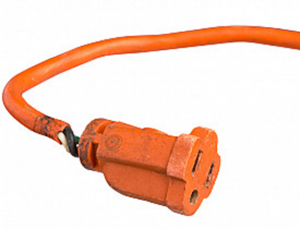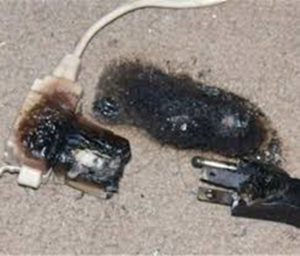Electrical Cord Safety

Even when extension cords, power strips, and surge protectors are being used correctly, some of these items can pose a serious fire and electrocution hazard.
The U.S. Consumer Product Safety Commission (CPSO) estimates that each year, about 4,000 injuries associated with electric extension cords are treated in hospital emergency rooms. About half the injuries involve fractures, lacerations, contusions, or sprains from people tripping over extension cords. Thirteen percent of the injuries involve children under-five years of age; electrical burns to the mouth accounted for half the injuries to young children. CPSC also estimates that about 3,300 residential fires originate in extension cords each year, killing 50 people and injuring about 270 others. The most frequent causes of such fires are short circuits, overloading, damage, and/or misuse of extension cords.
Since 1994, CPSC has announced 25 recalls involving 2 million extension cords, power strips, and surge protectors having undersized wires, loose connections, faulty components, or improper grounding.
Most of these faulty cords were sold at discount stores and small retailers. Most were made in China. Many have no identifying marks or model numbers. Some have counterfeit Underwriters Laboratories (UL) certification labels. Even small appliances can easily overload cords that do not meet industry safety standards.
Not enough cord for your lamp or radio to reach the nearest outlet. Just plowing through the junk drawer for an extension cord, this may not be a good idea. Extension cords can be very helpful in delivering power right where we need it. However, regardless of the gauge or rating of the cord, an extension cord is a temporary solution, and is not meant to be used as a long-term extension of your household’s electrical system.
Using extension cords properly is critical to your safety. With continuous use over time, an extension cord can rapidly deteriorate, creating a potentially dangerous electric shock or fire hazard.
A heavy reliance on extension cords is an indication that you have too few outlets to address your needs. Have additional outlets installed where you need them.
- Do inspect an extension cord for physical damage before use.
- Do check the wattage rating on the appliance or tool that the extension cord will be used with; do not use an extension cord that has a lower rating.
- Do make sure all equipment and extension cords bear the mark of an independent testing laboratory such as UL (Underwriter’s Laboratories).
- Do replace an outlet if a plug is too loose in the outlet.
- Do match up the plug and extension cord on a polarized cord (one hole on the plug is larger than the other).
- Do use GFCI (Ground Fault Circuit Interrupter) protection when using extension cords in wet or damp environments.
- Do pull on the plug, not the cord when removing an extension cord from the outlet.
- Do store extension cords indoors.
- Do keep slack in flexible extension cords to prevent tension on electrical terminals.
- Do put safety covers on the unused receptacle outlets on extension cords.

- Do not use an extension cord marked for indoor use outdoors.
- Do not plug one extension cord into another.
- Do not overload cords with more than the proper electrical load.
- Do not run extension cords through doorways, holes in ceilings, walls, or floors.
- Do not plug a three-prong into a two-hole extension cord.
- Do not use an extension cord when it is wet.
- Do not cover an extension cord with anything.
- Do not drive over an extension cord.
- Do not attach extension cords to the wall with nails or staples.
- Do not run extension cords under rugs or carpets or in high traffic areas.
- Do not use an extension cord to plug in a power strip. Instead, buy a strip with a longer cord.
